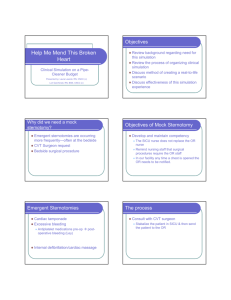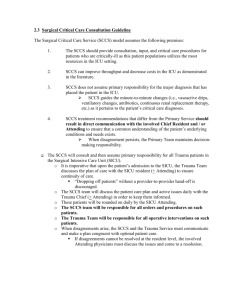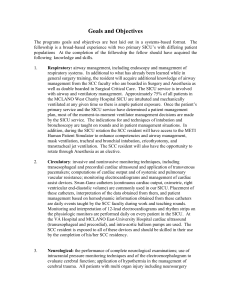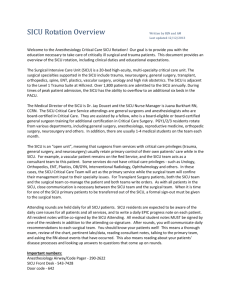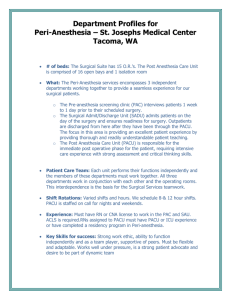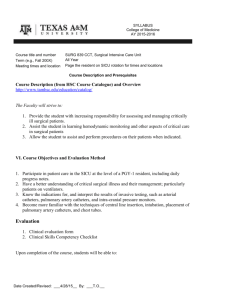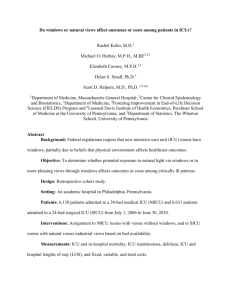Report on Current “Hand‐off” - Vanderbilt University Medical Center
advertisement
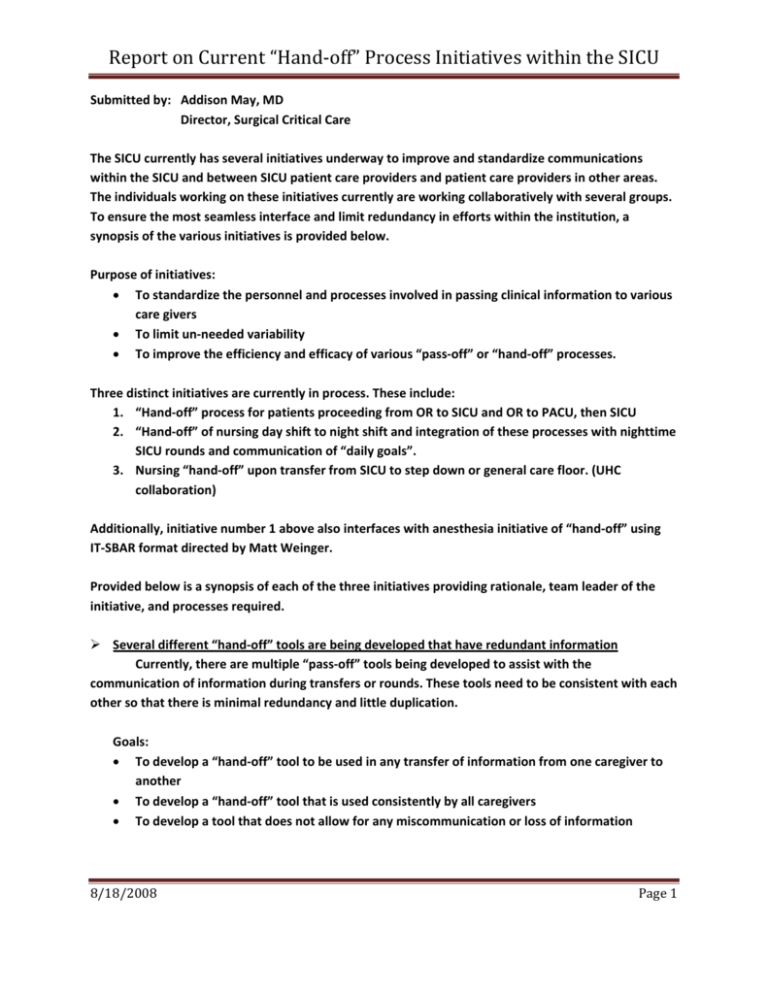
Report on Current “Hand‐off” Process Initiatives within the SICU Submitted by: Addison May, MD Director, Surgical Critical Care The SICU currently has several initiatives underway to improve and standardize communications within the SICU and between SICU patient care providers and patient care providers in other areas. The individuals working on these initiatives currently are working collaboratively with several groups. To ensure the most seamless interface and limit redundancy in efforts within the institution, a synopsis of the various initiatives is provided below. Purpose of initiatives: • To standardize the personnel and processes involved in passing clinical information to various care givers • To limit un‐needed variability • To improve the efficiency and efficacy of various “pass‐off” or “hand‐off” processes. Three distinct initiatives are currently in process. These include: 1. “Hand‐off” process for patients proceeding from OR to SICU and OR to PACU, then SICU 2. “Hand‐off” of nursing day shift to night shift and integration of these processes with nighttime SICU rounds and communication of “daily goals”. 3. Nursing “hand‐off” upon transfer from SICU to step down or general care floor. (UHC collaboration) Additionally, initiative number 1 above also interfaces with anesthesia initiative of “hand‐off” using IT‐SBAR format directed by Matt Weinger. Provided below is a synopsis of each of the three initiatives providing rationale, team leader of the initiative, and processes required. ¾ Several different “hand‐off” tools are being developed that have redundant information Currently, there are multiple “pass‐off” tools being developed to assist with the communication of information during transfers or rounds. These tools need to be consistent with each other so that there is minimal redundancy and little duplication. Goals: • To develop a “hand‐off” tool to be used in any transfer of information from one caregiver to another • To develop a “hand‐off” tool that is used consistently by all caregivers • To develop a tool that does not allow for any miscommunication or loss of information 8/18/2008 Page 1 Report on Current “Hand‐off” Process Initiatives within the SICU 1. “Hand‐off” process for patients proceeding from OR to SICU and OR to PACU, then SICU see attachment “SBAR Report Sheet for OR to ICU Handoff” Issues to be addressed: Currently, no standardized, approved process is in place to direct the flow of information for critically ill patients admitted to the SICU from the operating rooms or the PACU. These pass‐offs include information to be provided by anesthesia, surgical, nursing, and critical care personnel. The absence of defined processes may contribute to variation in practice, communication lapses and errors, and subsequent alteration in best practice. The hand‐off of information for patients going to the SICU has significant overlap with the needs and goals of those required by anesthesia providers when admitting a patient to the PACU. Thus, the anesthesia leader of the SICU initiative (Arna Banerjee) is collaborating closely with Dr Mat Weinger to incorporate similar tools and processes. Goals: • to define the appropriate personnel to personnel hand‐offs required for patients admitted for the OR and PACU to the SICU • to create a standardized process for hand‐offs and information flow • to identify tools to assist with ensuring consistent practice and limiting variability Processes: • The appropriate representatives of each team ‐ primary surgical team, anesthesia team, SICU team (RN, ACNP, and MD) required for appropriate information pass‐off must be determined and vetted. • Efficient and effective timing of information hand‐off must be determined for: o OR to SICU o OR to PACU to SICU (ICU admission determined on or before PACU admission) o OR to PACU to SICU (ICU admission requirement develops after admission to PACU) • Informatics tools to assist in both information flow and documentation must be developed and incorporated o Currently anticipate utilizing those tools developed by Mat Weinger’s initiative to facilitate process • Guidelines and/or standard operating procedures must developed that incorporate the 3 bullets above, approved, disseminated, and pushed into action for the groups involved o Processes must incorporate and be consistent with updated policies and operating procedures previously developed – (see attachments # 1‐3) o A draft process flow document is attached (attachment # 4) 8/18/2008 Page 2 Report on Current “Hand‐off” Process Initiatives within the SICU IT Requirements: • Need for the PACU Report to print to the ICU instead of PACU when the patient is going to the ICU from the OR. At present there is no way to print the PACU report to the SICU. • Need to be able to reprint the PACU report in the SICU for planned or unplanned SICU admissions from the PACU. • Current SBAR document provided as attachment #5a. Workaround: • The Anesthesia provider can print the Incomplete Anesthesia Report from Gaschart until we can print the PACU‐SBAR report to the ICU. • A blank SBAR note taking device can be used by the Anesthesia Provider / PACU RN and Bedside RN until we can print the PACU report to the SICU. Initiative team leaders: a. Arna Banerjee, MD b. Katie Beasley, ACNP c. John Shields, CRNA d. Audrey Kuntz, Educator for Perioperative Services 8/18/2008 Page 3 Report on Current “Hand‐off” Process Initiatives within the SICU 2. “Hand‐off” of nursing day shift to night shift and integration of these processes with nighttime SICU rounds and communication of “daily goals”. This initiative involves two separate but interrelated issues of communication and hand‐off. A) The communication and maintenance of patient therapy goals between the critical care team, the bedside nurse and hand‐off of this information across to the night shift and B) the nursing shift to shift report. These are described separately below but are overlapping. A) Bedside RN Daily Goal Report (See attachment “SICU Rounding Pt Goal Report”) Issues to be addressed: Currently, there is a standardized, approved process is in place to direct the flow of information for critically ill patients from nurse to the critical care team during MDSCC rounds. The nurse presents a set data to the MDSCC team during rounds so that the same information is shared for each patient. The data set that is presented is designed for the sole purpose of rounds. Documents currently utilized in these processes are provided as attachments: 5) MDSCC Process for Communication of Daily Goals 6) SICU Rounding_Pt Goal Report Ver2 7) Presentation – Bed Side RN Rounding Role Goals: • To improve the communication between nurse and the critical care team at the time of MDSCC rounds • To develop the tool so that there is little redundancy at the time of the rounds and little redundancy from the other “hand‐off” tools that are being developed • To develop the tool so that there is minimal difference from the design of the other tools Initiative team leaders: a. Michael Daly, SICU Manager b. Ashley Davis, SICU Assistant Manager B) Nurse‐to‐nurse end‐of‐shift handoff report Issues to be addressed: Currently, no standardization, approved process in place to direct the flows of information for patients between nursing staff at the end of a shift. Goals: • To develop a hand‐off tool to be used during end‐of‐shift report • To develop the tool so that there is little redundancy at the time of the “hand‐off” 8/18/2008 Page 4 Report on Current “Hand‐off” Process Initiatives within the SICU • To develop the tool so that there is minimal difference from the design of the other tools Initiative team leaders: c. Michael Daly, SICU Manager d. Ashley Davis, SICU Assistant Manager 8/18/2008 Page 5 Report on Current “Hand‐off” Process Initiatives within the SICU 3. “Hand‐off” between nursing staff of 9N, 9S, and SICU Issues to be addressed: Currently, there is a standardized, approved process is in place to direct the flow of information between nursing staff concerning patients transferring between 9N, 9S, and SICU. The use of this tool is inconsistent and was developed as part of a UHC initiative for improvement. Goals: • To improve use of the “hand‐off” tool between nursing staff of 9N, 9S, and SICU • To develop the tool so that there is little redundancy at the time of the “hand‐off” • To develop the tool so that there is minimal difference from the design of the other tools This collaborative initiative has currently created a draft document attached: • Attachment #8 Initiative team leaders: a. Michael Daly, SICU Manager b. Ashley Davis, SICU Assistant Manager c. Jay Morrison, CQI 8/18/2008 Page 6 Attachment 1: OR Number: 300-64* Section III: Nursing Policies/Procedures Review Responsibilities: Perioperative Svcs Effective Date: 10/82 Reviewed/Revised Date: 4/2003 TRANSPORT OF I.C.U. PATIENT TO THE OPERATING ROOM I. Policy: A. Transport to the OR: 1. 2. 3. B. Transport from the OR: 1. 2. II. If an ICU patient is intubated, the anesthesia provider and an ICU nurse will transport the patient to the operating room. If an ICU patient is not intubated, the ICU nurse and operating room transport personnel will accompany the patient to the operating room. For pediatric patients an attending Anesthesiologist, anesthesia provider and ICU nurse (if deemed necessary by the attending anesthesiologist) will accompany the patient to the operating room. Patients will be transported from the OR to the ICU or PACU by the anesthesia provider and a member of the surigcal team (attending, resident, phsycian assistant, medical student). Unstable patients will also be accompanied by the anesthesiology attending. Policy Application Guidelines applicable to: _____VUH _____VMG* _____VCH _____PHV X Other (specify): All Perioperative Services _____Exceptions(s):___________________________________ *includes satellite sites unless otherwise noted. III. IV. General Information: A. Patient identification guidelines will be followed (see VUH Patient Identification Policy). B. An I.C.U. patient may be admitted pre-operatively to the inpatient holding room provided he/she is hemodynamically stable. C. Patient's addressograph card, chart, and current MAR must accompany patient to the operating room. D. Postoperatively, the I.C.U. patient will either go to P.A.C.U or I.C.U., at the discretion of the attending surgeon and attending anesthesiologist. Appropriate notification to either the I.C.U. or P.A.C.U. is expected by the circulating nurse and report given by the anesthesia provider. E. Transport of pediatric patients to ICU accompanied by attending Anesthesiologist, resident, CRNA and Surgical resident. Cross References: A. V. Contributors: A. VI. Transport of Inpatients to the Operating Room B. Transport of Patients between Operating Rooms Michael Higgins, MD. MPH Distribution: A. All Perioperative Services Departments Signature Page for OR Policy # 300-64 VII. Endorsement: ____________________________________ Nancye Feistritzer, RN, MSN Administrative Director Perioperative Patient Care Center _____/_____/_____ Date ____________________________________ _____/_____/_____ R. Daniel Beauchamp, M.D. Date J.C Foshee Distinguished Professor of Surgery Surgeon-in-Chief, Vanderbilt Hospital Chair of Operating Room Committee ____________________________________ Jeff Balser, MD Chair & Prof of Anesthesiology Prof of Pharmacology _____/_____/_____ Date ____________________________________ Michael Higgins, MD, MPH Executive Medical Director, Perioperative Services _____/_____/______ Date Attachment 2: STANDARD OPERATING PROCEDURE DEPARTMENT OF ANESTHESIOLOGY VANDERBILT UNIVERSITY MEDICAL CENTER TITLE: Guidelines for Management of Intensive Care Unit patients in the PACU NO.XXX ESTABLISHED: 7/9/2003 APPROVED: PAGE NO. 1 OF 1 REVIEWED: REVISED: ===================================================== • • • SICU patients that are boarded in PACU and who require continuous infusion inotropic support or vasoactive medications will have the Multidisciplinary Surgical Critical Care service consulted immediately as is the policy for patients admitted directly to the SICU o Once notified, the SICU attending/triage officer with make every effort to speed the triage process to enable transfer to the SICU For patients anticipated to meet these criteria while still in the OR and no bed is available in the SICU, the anesthesia attending is encouraged to notify the SICU attending/triage officer (835-9637) to facilitate triage decisions and implementation For SICU boarders in the PACU that do not require continuous infusion inotropic support or vasoactive medications, the anesthesia attending will maintain responsibility for the period of their recovery from the anesthetic, typically 1 to 2 hours. After this point, the primary service will assume responsibility for management of the patient. If patients become more critically ill, a consult to the MDSCC service is encouraged to assist in management. Attachment 3: SICU Policy for Physician Notification by Nursing Staff for New or Acutely Unstable Patients in the SICU All acutely unstable patients: ¾ CT-service – the 1st call Cardiac SICU pager 835-8205 should be utilized. If appropriately timed response does not occur, page the Critical Care attending on-call pager 835-9637. ¾ Non-cardiac services – the 1st call Non-cardiac SICU pager 835-8207 should be utilized for all patients, regardless of Critical Care Service consultation status. If appropriately timed response does not occur, page the Critical Care attending on-call pager 835-9637. New admissions to SICU: ¾ The 1st call Cardiac SICU pager (835-8205) to be notified of all new CT service admissions upon arrival to the SICU ¾ The 1st call non-cardiac SICU pager (835-8207) to be notified for all non-cardiac patients that require continuous infusion vaso-active agents upon admission to the SICU. all non-cardiac patients for whom the primary service requests admission any non-cardiac patient with acute change in clinical status any time that uncertainty exists only non-cardiac patients that 1) do not have a Critical Care consultation, 2) do not require continuous infusion vaso-active agents, and 3) are stable do not require notification of the 1st call pager (example – post-op patients admitted for monitoring of flap perfusion) Previously admitted patients that return from the OR to the SICU ¾ Notify the appropriate 1st call pager for all CT patients and non-cardiac patients with consultations upon arrival from the OR. ____________________________ Addison K. May, MD Medical Director, SICU Attachment 4: DRAFT: SICU Peri-operative Report Process I. Process a. OR directly to SICU i. Anesthesia MD calls SICU Attending/Fellow* to give report ii. CRNA/SRNA/Resident calls SICU Charge Nurse (CN)* iii. Report (PACU report from Gaschart) printed out in SICU by the CRNA/ SRNA/Resident prior to the phone call to the SICU Charge Nurse to give report. iv. CN notifies bedside RN, ACNP, and SICU resident and transfers information. v. Medical Receptionist (MR) receives rolling call (patient is leaving OR) from OR circulating nurse. vi. MR text pages ACNP, SICU resident on call, SICU Fellow, (as applicable per SICU policy) and CN, and if possible bedside RN** about patient arrival. (Please see SICU Policy for Physician Notification by Nursing Staff for New or Acutely Unstable Patients in the SICU – Attached). vii. At bedside-hard copy of SBAR report is given to bedside nurse (this does not replace verbal report but serves as a communication tool). (A note taking blank form – Blank SICU OR - ICU Handoff.pdf; attached) viii. Surgeon/Surgical Attending involved in case provides report of goals and patient condition to SICU mid-level, Fellow/Attending upon admission to ICU b. OR to PACU (planned SICU admission) i. Anesthesia MD calls SICU Attending/Fellow to the PACU on patient arrival to the PACU. ii. SICU Fellow meets Anesthesia MD at bedside in the PACU and receives SBAR report in PACU from the CRNA/SRNA/Resident at the patient’s bedside along with the PACU Nurse. iii. Medical Receptionist (MR) receives rolling call (patient is leaving the PACU) iv. MR pages ACNP, SICU resident on call, SICU Fellow, (as per SICU notification policy – see attached) and CN, if possible bedside RN v. At bedside-hard copy of SBAR report is given to bedside nurse by the PACU RN during transfer. (this does not replace verbal report but serves as a communication tool). (A note taking blank form – Blank SICU OR - ICU Handoff.pdf; attached) vi. Surgeon/Surgical Attending involved in case provides report of goals and patient condition to SICU mid-level, Fellow/Attending upon admission to the PACU. c. OR to PACU (unplanned SICU admission) i. Anesthesia PACU Resident calls SICU fellow with report (SBAR report). ii. PACU RN calls SICU bedside RN (SBAR report) iii. Medical Receptionist (MR) receives rolling call (patient is leaving PACU) iv. MR pages ACNP, SICU resident on call, SICU Fellow, (per SICU notification policy) and CN, if possible bedside RN v. At bedside-hard copy of SBAR report is given to bedside nurse by the PACU RN. (this does not replace verbal report but serves as a communication tool). (A note taking blank form – Blank SICU OR - ICU Handoff.pdf; attached) vi. SICU mid-level, Fellow/Attending contacts the Surgeon/Surgical Attending involved in case to obtain report of goals and patient condition to upon admission to ICU II. Required personnel at bedside a. OR directly to SICU i. Anesthesia MD (unless the patient meets the following criteria – only non-cardiac patients that 1. do not have a Critical Care consultation 2. do not require continuous infusion vaso-active agents 3. are stable do not require notification of the 1st call pager (example – post-op patients admitted for monitoring of flap perfusion) ii. CRNA/SRNA/Resident iii. SICU Fellow (or mid-level) for all patients that 1. Require vaso-active agents 2. Have resuscitative needs or cardiopulmonary instability iv. ACNP and/or On-call SICU Resident v. Primary Nurse b. OR to PACU to SICU (planned or unplanned admission) i. SICU Fellow ii. ACNP iii. On-call SICU Resident iv. PACU RN v. Primary Nurse III. Standard of information- SBAR report. Please see attached documents 1. Handoff- OR-ICU.ppt 2. Blank SICU OR - ICU Handoff.pdf IV. Monitoring mechanism All patients have to be transported with a transport monitor. Required Vital Signs: a. SpO2 b. EKG c. NBP cycled q5minutes or ABP d. If possible ETCO2 * Phone numbers for the following people will be readily available in the OR: SICU Fellow, SICU Attending, and SICU CN. ** MR can set up pager list in email outlook to page ACNP, fellow, on-call resident, and CN. Arna Banerjee, MD Katie Beasley, ACNP-BC Reviewed: Addison May, MD 5/21/2008 Attachment 5a: SBAR REPORT (30” PRIOR TO TRANSPORT) NAME:_______________________ AGE: _____ HT:____ WT:____ ALLERGIES:___________________________________ DIAGNOSIS_____________________________________ PROCEDURE:__________________________________ LINE LOCATION: PAC _____________ MAC/CORDIS __________ OTHER CENTRAL_______ PIV(S) __________ ALINE __________ OTHER MONITORS_____ AIRWAY: INTUBATED? _______ REVERSED/EXTUB?__ MASK/NC?__________ C-SPINE ISSUES?____ OXYGENATION?______ ABG’S? _______ INTAKE: CRYSTALLOIDS _______ PRBC _______ FFP _______ PLATELETS _______ OUTPUT: EBL_______________ UOP_______________ CT________________ DRIPS: AMICAR AMIO DOBUTAMINE DOPAMINE EPI INSULIN OTHER: ________ LEVOPHED _____ ________ MILRINONE _____ ________ NEO _____ ________ NITROGLYCERIN ___ ________ NIPRIDE _____ ________ PROPOFOL _____ _____________________________________________ MEDICATIONS: ANTIBIOTICS________ SEDATIVES/PARALYTICS_________ PATIENT ISSUES ABNORMAL LAB VALUES: ___________________________________ VITAL SIGNS (HR,BP) STABLE/UNSTABLE: _____________________ May 2, 2007 Attachment 5: VANDERBILT UNIVERSITY MEDICAL CENTER MULTIDISCIPLINARY SURGICAL CRITICAL CARE Process for Communication of Daily Goals Across Patient Care Team • • • High level critical care support of the surgically critically ill is a multidisciplinary process that is complex, labor intensive and mandates that all team members throughout a 24 hour period are cognizant of the daily goals of an individuals care plan. Daily goals should be understood and communicated equally to all team members involved in the patient’s care over the 24 hour period. This SOP provides the mechanism by which these goals are to be communicated to the day and night time care teams Day Shift Process: 1. Prior to Actual AM Rounds: a. Night Shift Nurses complete SICU Rounding/Pt Goal Report b. Night Shift Nurses and Day Shift Nurses Review SICU Rounding/Pt Goal Report during change of shift report c. Resident rounds and begins Critical Care Progress Note 2. Actual AM Rounds: a. Resident Presents b. Respiratory Therapist Presents c. Nurse Presents d. Nutritional Specialist Presents e. Resident Presents f. Pharmacist Presents g. Faculty/Fellow Discusses Daily Goals/Plan 3. Clarification of any misunderstandings 4. Daily Goals documented on SICU Rounding/Pt Goal Report Afternoon Pass-off and PM Process • The daytime process outlined above needs to be expanded to enable to communication of daily goals to be carried through to night time resident and fellow staffing and to night time nursing and respiratory therapy. 5. Fellow to fellow pass-off: • SICU Fellow should ensure that the goals stated and recorded for during the morning rounding process are passed to the nighttime cross-covering fellow. • This may be done using either the duplicate sheets from rounds or at bedside with the nursing documentation sheet. 6. Prior to PM nurse shift change: a. Day Shift Nurses complete SICU Rounding/Pt Goal Report May 2, 2007 b. Day Shift Nurses and Night Shift Nurses Review SICU Rounding/Pt Goal Report during change of shift report 7. PM multidisciplinary rounds: a. Each night (between 7:30 and 9pm), PM multidisciplinary rounds should occur to update the plans of care and ensure that physician, nursing, and respiratory staff all have the same understanding of goals of care. • If the fellow cannot initiate by 9 pm, the midlevel resident should confirm and then begin this process b. Members to be present: • CC fellow (unless clinical emergencies preclude presence) • Mid-level resident • Intern (unless competing clinical duties preclude presence) • Bedside nurse • Respiratory therapist • Charge nurse (unless competing clinical duties preclude presence) c. Progress towards daily goals should be discussed and documented on the SICU Rounding/Pt Goal Report • Resident Presents any changes or updates that occurred throughout the day • Nurse presents any changes or updates that occurred throughout the day • Respiratory Therapist presents any changes or updates that occurred throughout the day • Charge Nurse presents any changes or updates that occurred throughout the day • Fellow Updates Daily Goals/Plan and PM nurse records on sheet Reviewed and approved by the MDSCC faculty and nursing management Approved by: Addison K. May, MD, FACS, FCCM Associate Professor of Surgery and Anesthesiology Director, Surgical Critical Care Attachment 6: SICU Rounding/Pt Goal Report Date: _________ Pt. Name: _______________________ Bed: ____________ Nurse-to-Nurse Report: ROOM Safety Check/Documentation (Initial when completed) 7P-7A 7A-7P IV tubings timed, labeled, and dated? Emergency Airway supplies at HOB? Ambu covered? Monitor alarm limits at appropriate settings and on? Specialty bed controls/function? CDR completed and signed? Weight done? Current Pathway reviewed? MAR Review? Restraint orders reviewed? Discharge plan reviewed? Pt. Family Education Record updated? Consent to treat CCT Rounding Report: Code Status: Today’ Weight: Vital Signs T(Max): BP: HR/Pulse: Neuro Status Sedation (RASS/CAM): 7P-7A Vitals Comments 7A-7P Vitals 7P-7A Nuero Status 7A-7P Neuro Status ______ / ______ ______ / ______ 7P-7A BG Mgmt 7A-7P BG Mgmt Comments Pain Mgmt: Blood Glucose Mgmt: Insulin Protocol(Yes/No): BG Ranges (24 hrs): Drips/IV Fluid Tube feeding Output Low: High: 7P-7A Intake Rate/Titrating/Response Low: High: 7A-7P Intake Total Intake: (24-Hr) 7P-7A output UOP: JP: NGT/OGT: Chest Tube: Wound Vac: (Day shift) 7A-7P output Total Output: (24-Hr) (Day shift) Rate/Titrating/Response Clinical Pathway (Doc. In HED):__________________________________________________________________________ Pertinent Issues that need to be discussed with Critical Care Team: Can pt. tolerate spontaneous breathing trial? _____________________________________________________________ Pressure Ulcers (Braden Score): _________________________________________________________________________ Feeding/Diarrhea/Nausea: _______________________________________________________________________________ Wounds/Incisions: _______________________________________________________________________________________ Radiology/Procedures: __________________________________________________________________________________ Family:__________________________________________________________________________________________________ __________________________________________________________________________________________________________ What nursing care can be done to help ready patient for move out of SICU? ______________________________ __________________________________________________________________________________________________________ __________________________________________________________________________________________________________ Patient’s Daily Goals determined during CCT rounds 7A – 7P 7P – 7A Neuro/Sedation: Sedation/pain management? __________________________________________________________________________________________________________ __________________________________________________________________________________________________________ Pulmonary: Vent Settings: HOB 30 or greater (if not, why?) RASS/Cam--Eligible for Spont. Breathing Trial? If no, why? PUD prophylaxis? If no, why? DVT Prophylaxis? If no, why? Oral care complete? If no, why? _________________________________________________________________________________________________________ __________________________________________________________________________________________________________ CV (incl. organ perfusion): Cardiac: rhythm, HD #s Beta Blocker? __________________________________________________________________________________________________________ __________________________________________________________________________________________________________ Renal: ___________________________________________________________________________________________________ __________________________________________________________________________________________________________ __________________________________________________________________________________________________________ Nutrition/GI: GI: nutrition, Bowel regimen, tubes __________________________________________________________________________________________________________ __________________________________________________________________________________________________________ Infectious Disease Issues: Infection Control/Cultures/Isolation? __________________________________________________________________________________________________________ __________________________________________________________________________________________________________ Heme/Endocrine: Blood Glucose Control BG Range:__________ BG Range: ________ Sliding scale or drip? Insulin given: _______ Insulin given: ______ __________________________________________________________________________________________________________ __________________________________________________________________________________________________________ Skin/Wound: Wounds/incisions? Skin issues: Braden? Specialty bed? Dressing changes for next shift? __________________________________________________________________________________________________________ __________________________________________________________________________________________________________ Diagnostics/Procedures: Labs needed to be drawn? Radiology/CT/other? Pending? Procedures? __________________________________________________________________________________________________________ __________________________________________________________________________________________________________ Family: Family Issues: __________________________________________________________________________________________________________ __________________________________________________________________________________________________________ Other/Consults? Mobilization/ OOB? __________________________________________________________________________________________________________ __________________________________________________________________________________________________________ Attachment 7: Critical Care Team Rounding Surgical ICU May 8, 2006 Who are the Critical Care T Team members? b ? • • • • • • • Attending &/or Fellow Physician Nurse R Respiratory i t Th Therapist i t Residents Nutritionist Pharmacist Infection Control Reason for Changes • Begins Monday, May 8, 2006 • To allow all team members to have adequate input into each patient’s care • Improve communication • Improve decision-making • Improve teamwork • Improve family-centered care p efficiency y • Improve HOW THE NEW PROCESS WORKS? 1 2 3 Medical Receptionist Inserts blank Bedside RN Presentation Sheet into the patient chart Night Shift RN completes Bedside RN Presentation Sheet 4 5 Critical Care Team Starts Rounds 6 Critical Care Team pp p patient approaches bedside 7 Critical Care Team proceeds with discussion During Sign off btw shifts Night Shift RN and Day Shift RN discuss the information on the Bedside RN Presentation Sheet Patient Case discussion starts with Day Shift RN presenting p g information from the Bedside RN Presentation Sheet 8 Critical Care Team Completes rounds 9 Critical Care Team Procedure huddle Attending &/or Fellow Physician’s Role – Lead rounds – Ask necessary questions – Finalize patient plan of care Night Shift Nurses Role – Complete Bedside RN Round Presentation Sheet – Review the Bedside RN Round Presentation Sheet with the day shift RN during hand-off report – Di Discuss ffamily il concerns with ith d day shift hift RN so th thatt th they can be resolved effectively Day Shift Nurses Role – Review the Bedside RN Round Presentation Sheet with the night shift RN during hand-off report – Present data on the Bedside RN Round Presentation Sheet during rounds – Ask questions during rounds Bedside RN Rounds Presentation Sheet • • • • Tmax BP HR/Pulse Neurological Status – Sedation (RASS/CAM) – Pain Mgt – IV Fluids – Insulin Protocol – I&O – Braden Score – 24H Nursing u s g Issues ssues Respiratory Therapist’s Role – Present current ventilator settings – Present current ABG and respiratory compliance – Ask questions Resident’s Role – Present patient’s history and background – Present events during the past 24 hours – Present significant/relevant physical exam findings Pharmacist’s Role – Present medication concerns – Review antibiotic compliance – Present Protocol Compliance Nutritionist’s Role – Present nutrition data specific to that patient – Present estimated caloric requirements – Provide P id suggestions ti ffor iimprovementt Infection Control Control’s s Role – Will be determined in the future Procedure Board • Following rounds rounds, the team will huddle around the procedure board to prioritize and plan the timing of all procedures • Located L t d jjustt right i ht off the service center door Moving Forward • In an effort to ensure success, changes will occur as the process evolves to make it as easy as possible for all team members members. • Mike Daly and Kristina Statnikova will round with the team for the first few weeks to help implement and obtain feedback about the process • If you have any suggestions after rounds please forward to Mike Daly Attachment 8: SBAR Transfer Handoff Communication Template Date: Situation Patient Name/DOB Attending MD/Service: Diagnosis/Procedures: Code Status: Background PMH: Allergies: Vital Signs: GI Tmax: GU (Foley?– Plan): Neuro: CV: Skin/Incision/Wounds/Pressure Ulcers: Resp: Dressing Changes/Schedule: Treatments/Volurex: Pain Control/Plan: Resp Notified of Transfer_______ IV access/Drains/Tubes: Diet: Tests/Significant Lab Results: Bld Gluc: Meds/Drips: Follow up: Assessment Current Issues/Concerns: Activity/Goal: Isolation: Safety-(Restraints/Falls Risk/Other): Family/Social: Recommendations Patient Goals/Discharge Plan: Questions? Sending Note Documented in HED_____________ SICU: 2-0988 9N: 2-0918 9S: 2-0916 Receiving Note Documented in HED______________ Meds, Personal Belongings, supplies (TF, Trach Kit, etc) accompanying Patient?__________________ Name of RN giving/receiving report: ________________/_________________ ETA: Who is currently consulting on the Pt? Respiratory_____ PT/OT_____ Speech Therapy_____ WOCN_____ Social Work_____ Attachment 8: SBAR Transfer Handoff Communication Template Date: Case Management_____ Nutrition Services_____ Other______ Did the sender/receiver (circle one) use this form for the handoff communication? Y N What did you like about the form/format? 1. 2. 3. What would you change/add to the form/format? 1. 2. 3. DOCUMENTATION REMINDER: Attachment 8: SBAR Transfer Handoff Communication Template 0700/19000800/20000900/2100- Date: Did the sender/receiver (circle one) use this form for the handoff communication? Y N 1000/22001100/23001200/00001300/0100- What did you like about the form/format? 1. 2. 3. 1400/02001500/03001600/04001700/05001800/0600- What would you change or add to the form/format? 1. 2. 3.
